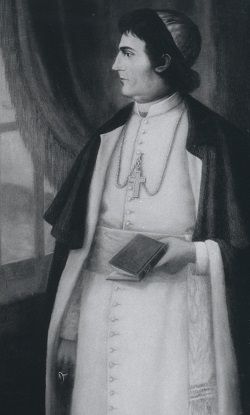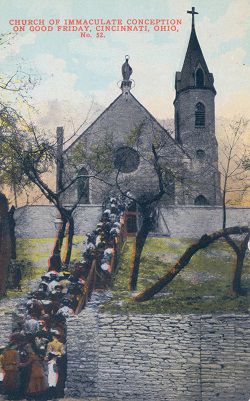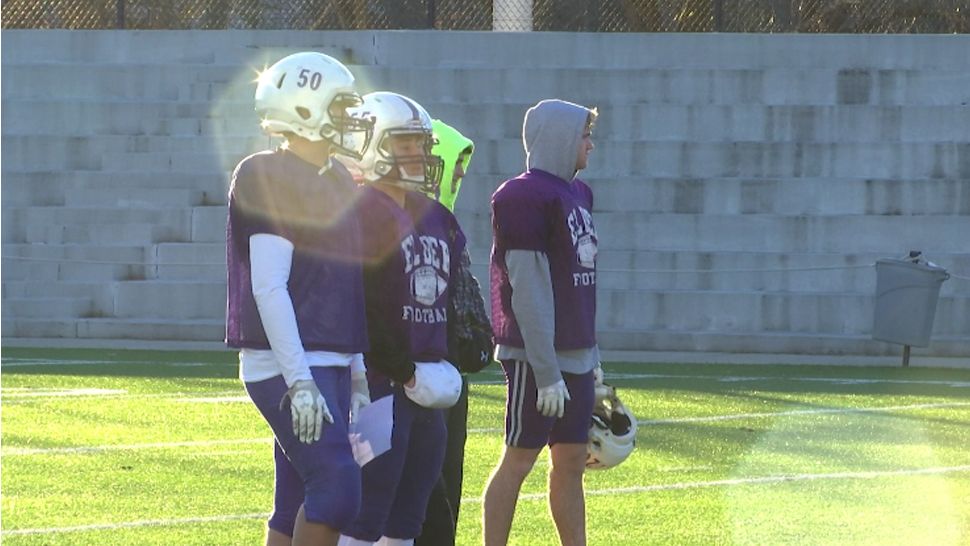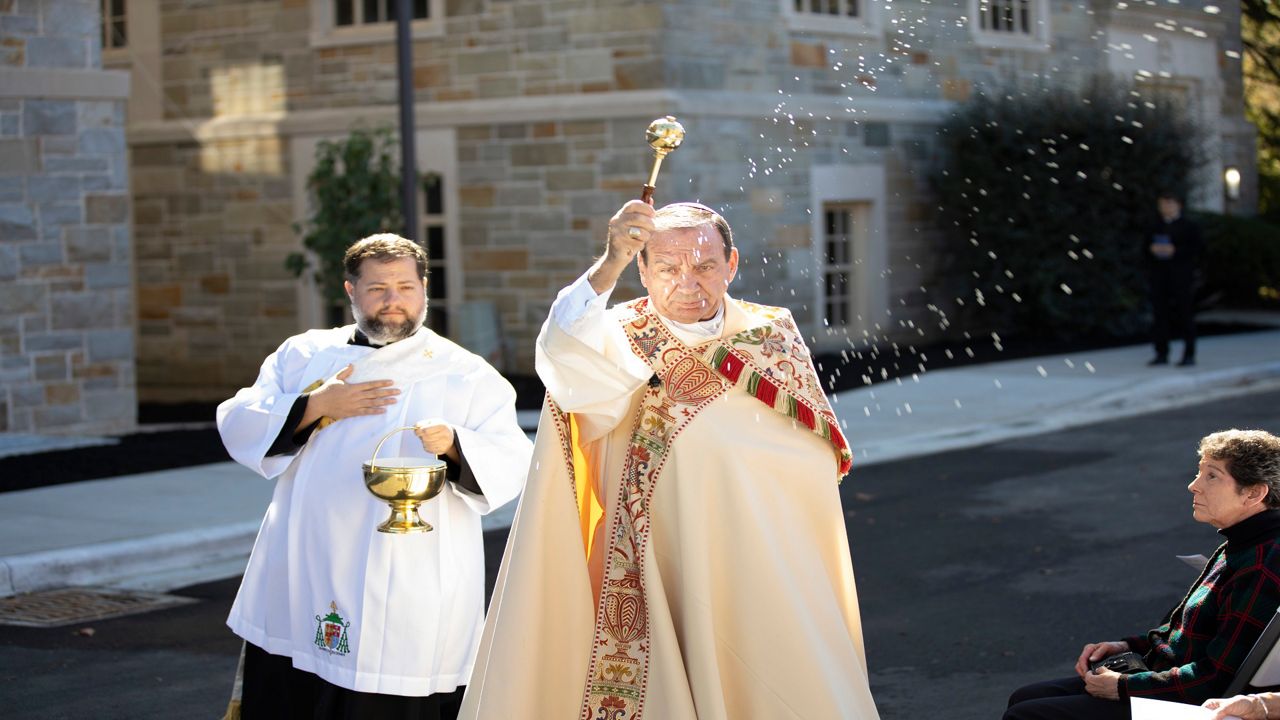CINCINNATI — Irish and German settlers. High school rivalries. McDonald’s famous fish sandwich.
Over the past 200 years, the Roman Catholic Church has played a role in Cincinnati's development and the broader region. Not simply on Sundays or in a spiritual sense, but in social and cultural ways as well.
What You Need To Know
- Archdiocese formed by Rome in 1821
- First bishop was Edward Fenwick
- Catholicism has impacted religious and secular life in Cincinnati for the past 200 years
- Cultural impacts seen today in many local traditions
One of the biggest factors behind Catholicism's growth in this part of the world was the establishment of a diocese (later, becoming an archdiocese) here two centuries ago.
A decision that shaped many elements of life in the Queen City: the education system, the hospitals and social services, even some favorite summer pastimes. Definitely the food.
"Whether you’re a Catholic or not, if you live in Cincinnati, your life has been touched in some way by the Catholic Church. Whether it's from Catholic Charities or healthcare or schools," said Fr. David Endres, author of the new book, "A Bicentennial History of the Archdiocese of Cincinnati."
On Saturday, the Archdiocese of Cincinnati will mark its bicentennial with a day of events, pageantry and, as you might expect, a Mass. The service begins at 11 a.m. at the Cathedral Basilica of St. Peter in Chains.
The day will also serve as the conclusion of a more than 300-mile pilgrimage that began May 16 in Russells Point, Ohio. It will wrap up at Fountain Square, where a family concert will take place from noon to 4 p.m.
"On June 19 we celebrate the 200 years of faith since the establishment of our local Church, but the depth of our faith is far more important than the number of years," said Archbishop Dennis. M. Schnurr. "May our faith always remain strong and may we radiate the love of Christ to all whom we encounter every day.”
The number of Catholics in the city of Cincinnati has dipped below its peak of more than 300,000 in the mid-20th century when they numbered one-third of the population.
However, the Catholic Church continues to impact the day-to-day life of hundreds of thousands of people across the 19-county archdiocese.
How it started
The Diocese of Cincinnati was established June 19, 1821 — exactly 200 years from this Saturday. At the time, Cincinnati was just the ninth diocese in the now-defined United States. It was only second west of the Appalachian Mountains, following Bardstown, Ky.
But that wasn't the birth of Catholicism in southwest Ohio. Not by at least a decade, said Walker Gollar, a professor of church history at Xavier University.
"About 10, 15 years before (1821), there were already Catholics in Cincinnati and Ohio, but there weren't really any priests in the area at that point," he said. "The faith really grew as a result of devoted mothers and fathers praying the rosary in their house, teaching their children, and fostering the faith."
Gollar said many of the early Catholic settlers in this region were German and Irish immigrants. He credited Michael Scott, an immigrant from Ireland, with hosting the first Mass in the area, likely said by the traveling missionary and future bishop, Edward Fenwick.
When a traveling missionary was not available for Mass, Scott, who lived in what would now be downtown Cincinnati, invited family and neighbors inside his home to worship with him.

That happened around 1810. The region's first Catholic church, Christ Church, was constructed in 1819, two years prior to the diocese designation.
The establishment of a diocese helped institutionalize and grow the faith. It also brought with it many of the services Cincinnatians still benefit from today.
Schools, hospitals, social services and, of course, more churches.
At its founding, the diocese spanned a much larger area than it does today. It encompassed Ohio, Michigan and even parts of Wisconsin.
"It went from Cincinnati to Mackinac Island in northern Michigan to Sault Ste. Marie into Green Bay in Wisconsin," said Endres, who is also academic dean at Mount St. Mary’s Seminary in Cincinnati.
Endres said the city's first bishop, Edward Fenwick, played a major role in establishing Catholicism throughout the region.
"It wasn't just European settlers, but also some Native American peoples in Wisconsin and Northern Michigan. A huge part of our story is setting up churches and ministering to those communities," Endres said.
Many of those churches still exist today, Gollar said.
While Fenwick had some success, he didn't initially receive the money or support from Rome to do his job.
“His job was to organize all the Catholic families that were already here. His job was to build a cathedral and churches and schools, but really with no money," Gollar said of Fenwick. "He was charged to organize and create all of that, but he was really on his own."
Gollar said that it was so bad at one point that Fenwick travelled to Rome in 1824 to resign.
"He said, 'I can’t do this,' and the pope refused to accept his resignation. The pope told him to go back to Cincinnati and see what you can do," according to Gollar.
Both Gollar and Endres credit Cincinnati's second bishop, the Irish-born John Baptist Purcell, with helping to shape the Catholic Cincinnati that is known today. Purcell served as bishop of Cincinnati from 1833 to his death in 1883.
"He was the bishop during the time of great immigration and really supported those communities," Endres said of Purcell.
"Purcell was also very public and even political during his time as bishop," Endres added. "He was known to debate Protestant ministers publicly and was an outspoken supporter of President Lincoln during the Civil War."
Cincinnati earned the title of archdiocese in 1850.
Beer? No, Fish. But, beer, too.
When people think of the foods and beverages that define Cincinnati, one of the first things that comes to mind is beer. Given the number of breweries and bars the city had in its history, it makes sense.
Another option is pork. Cincinnati earned its nickname "Porkopolis" for a reason after all.

Yet, arguably the most influential food for Cincinnati Catholics has been fish. This is due in part to the religious tradition of not eating meat on Fridays, especially during Lent.
You can thank Lou Groen and Cincinnati Catholics for the McDonald's Filet-O-Fish sandwich.
"The story goes, McDonald's was looking for a meatless option to sell to Catholics for Lent. They suggested a Hawaiian burger (Hula Burger) -- it was like a piece of pineapple with some sauce and a bun. The owner of a local McDonald's franchise (Groen) said that wouldn't work, so he suggested a fish sandwich," Endres recalled.
"They told him to sell both in Cincinnati and see which one sold better," he said. "Now, the fish sandwich appears on all menus."
But it wasn't all about nourishment or food options. Sometimes the food was just an excuse to get together.
"Fish fries have been a big part of the Catholic story in Cincinnati and elsewhere," said Gollar. "Pretty early on churches would use fish fries as fundraisers during Lent. They would be carnival-like atmospheres, sometimes with a beer garden. It was a good way to raise money and get to know your neighbor."
That sense of community is important, Endres said.
"We as Catholics connect very well with the cultural aspects of the faith. The popularity of fish fries and church festivals are two examples of that," he said. "These are opportunities for parish members to get together, to serve each other and really get to know each other."
Another uniquely Cincinnati tradition is Praying the Steps at Immaculata Church. Each Good Friday thousands of locals -- some not even Catholic -- travel to Mt. Adams to pray and walk up the 94 steps to the iconic church overlooking the city.
Endres has lived and worked in Greater Cincinnati most of his life. He said it's interesting to see how some communities embrace fish fries while others are more about church festivals.
Of course, these events aren't all about religion. They're about community. They're about Cincinnati.
"People all over Cincinnati get excited for these events," Gollar said. "Not all of my neighbors are Catholic, but they know the place that serves the best fish fry or has a festival they enjoy most. At some point it just becomes a Cincinnati thing."
Developing a sense of community
If you walk into any Catholic church or attend a Mass, you'll see a lot of similarities. The Roman Catholic religion has a core set of beliefs and practices that are universal.
But beyond the Mass and sacraments, each parish has its own unique style.
"Parishes are like people in that they have their own personalities," Endres said. "We share one faith, unity of belief and practice, but that doesn’t mean you’re in lock-step uniformity with others.”

At its peak, there were around 100 churches in Cincinnati and Hamilton County. Most of them were in the urban core. Now, that number is down to around 70 and the parishes are more spread out, with clusters in the northern and western parts of the county.
Endres cited differences ranging from the types of music to the emphasis of sermons, to devotional expression of faith in the community. Much of that uniqueness has roots in the diversity of those in the pews.
"No two churches are the same. Based on who's in a parish, the church down the street can be very different than yours," he said.
In 1840, roughly 30 percent of Cincinnati's population spoke German. And nearly 8,000 of the city's 12,000 Catholics were German.
"The Irish and German immigration movement in the 1830s through the 1850s was very significant in this part of the world," said Endres. "Not only did they make up a significant percentage of the population, but they made up a huge percent of our church."
So, it should come as no surprise that one of the first churches the new diocese built was German speaking.
Holy Trinity Church, or in German, Heilige Dreieinigkeit, was built in 1834. The West End church was one of nine German Catholic churches built in Cincinnati proper in the 1800s.
Endres said one of the primary jobs of the diocese during that time was to serve the needs of its congregation.
"There was a tremendous need to minister to them in their own languages, especially the Germans," Endres said. "But it was more than just religion. The diocese helped set up schools and other services for their benefit as well."
Similar immigration movements took place throughout the later 19th century. The diocese created churches and served immigrants who were Italian, Hungarian, Polish, Lithuanian and Syrian.
Today, the church is embracing an influx of populations from Africa, Asia and Latin America.
Of course, developing a sense of a community is bigger than sharing a common language - though, it doesn't hurt. It's about feeling comfortable and knowing your neighbor.

The Archdiocese of Cincinnati has tried to accomplish that through a large school system.
While only the 44th largest archdiocese in the country, it has the fifth-largest Catholic school system. There are more than 100 schools in the archdiocese, including 23 high schools.
Elder. LaSalle. Moeller. Mercy McAuley. Mount Notre Dame. Ursuline.
A person's allegiance to one of those schools may result in a Friday night football rivalry or soccer pitch. But it will also create a broader sense of a community.
Not just in terms of religious life but in secular life as well.
"In Cincinnati there are two commonly asked questions when you meet someone: East side or West Side? And what high school did you attend?'" Endres said. "It shows how important it is to have a sense of belonging and community."
About the bicentennial celebration
Bicentennial Marian Pilgrimage
The longest Marian Pilgrimage in the U.S ends this Saturday at Fountain Square. Over the last month 30 days, thousands of faithful and hundreds of volunteers have participated in events and carried a statue of the Mary on a pilgrimage that will culminate with the Mass of Thanksgiving and Bicentennial Celebration on Fountain Square.
Bicentennial Mass: 11 a.m. Cathedral Basilica of St. Peter in Chains
A Solemn Mass of Thanksgiving on the Bicentennial Anniversary of the Founding of the Church of Cincinnati will be celebrated at the Cathedral Basilica of St. Peter in Chains on Saturday at 11 a.m. The Mass will be celebrated by Archbishop Dennis. M. Schnurr. The public is invited to attend. At the conclusion of the Mass Archbishop Schnurr will reconsecrate the archdiocese.
Family Concert: 12 p.m.- 4 p.m. Fountain Square
At noon, the reconsecration of the archdiocese will be live-streamed from the Cathedral Basilica of St. Peter in Chains. Following the broadcast multicultural performances, choirs and food trucks will entertain the crowd through the afternoon. All are invited to join the celebration.
For more information, visit https://200.catholicaoc.org/



